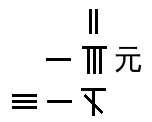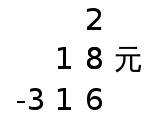Biography:Li Ye (mathematician)
Li Ye (Chinese: 李冶; Wade–Giles: Li Yeh; 1192–1279), born Li Zhi (Chinese: 李治), courtesy name Li Jingzhai (Chinese: 李敬斋),[1][2] was a Chinese mathematician and writer who published and improved the tian yuan shu method for solving polynomial equations of one variable.[3][4][5][6][7][8] Along with the 4th-century Chinese astronomer Yu Xi, Li Ye is one of the few Chinese mathematicians to propose the idea of a spherical Earth instead of a flat one before the arrival of European science in China during the 17th century.
Name
Li Ye was born Li Zhi, but later changed his name to Li Ye to avoid confusion with the third Tang emperor who was also named Li Zhi, removing one stroke from his original name to change the character. His name is also sometimes written as Li Chih or Li Yeh. His literary name was Renqing (Chinese: 仁卿; Wade–Giles: Jen-ch’ing) and his appellation was Jingzhai (Chinese: 敬斋; Wade–Giles: Ching-chai).[1][2]
Life
Li Ye was born in Daxing (now Beijing). His father was a secretary to an officer in the Jurchen army. Li passed the civil service examination in 1230 at the age of 38, and was administrative prefect of Jun prefecture in Henan province until the Mongol invasion in 1233. He then lived in poverty in the mountainous Shanxi province. In 1248 he finished his most known work Ceyuan haijing (測圓海鏡, Sea mirror of circle measurements).[1][9] Li then returned to Hebei.
In 1257 Kublai Khan, grandson of Genghis Khan, sent for Li to get advice on government and science. In 1259 Li completed Yigu yanduan (益古演段, New steps in computation), also an important mathematics text. After becoming Khan, Kublai twice offered Li government positions. He politely declined, referring to his age and ill health. In 1264 Li finally accepted a position at the Hanlin Academy, writing official histories. He was critical of the politics and resigned after a few months, again citing ill health.[4] He spent his final years teaching at his home near Feng Lung mountain in Yuan, Hebei. Li told his son to burn all of his books except for Sea mirror of circle measurements. Fortunately other texts, both mathematical and literary, still survived.[1]
Work in mathematics
Ceyuan haijing
Ceyuan haijing (Sea mirror of circle measurements) is a collection of 170 problems, all related to the same example of a circular city wall inscribed in a right triangle and a square.[1][10] They often involve two people who walk on straight lines until they can see each other, meet or reach a tree in a certain spot. It is essentially an algebraic geometry book, the purpose of book being to study intricate geometrical relations with algebra and provide solutions to equations.[11]
Many of the problems are solved by polynomial equations, which are represented using a method called tian yuan shu, "coefficient array method" or literally "method of the celestial unknown".[1][12] Li Ye is the earliest known source of this method, though it was known before him in some form. It is a positional system of rod numerals to represent polynomial equations.
For example, 2x2 + 18x − 316 = 0 is represented as
 which is equal to
which is equal to  in Arabic Numbers.
in Arabic Numbers.
The 元 (yuan) denotes the unknown x, so the numerals on that line mean 18x. The line below is the constant term (-316) and the line above is the coefficient of the quadratic (x2) term. The system accommodates arbitrarily high exponents of the unknown by adding more lines on top and negative exponents by adding lines below the constant term. Decimals can also be represented. Later, the line order was reversed so that the first line is the lowest exponent.
Li does not explain how to solve equations in general, but shows it with the example problems. Most of the equations can be reduced to the second or sometimes third order. It is often assumed that he used methods similar to Ruffini's rule and Horner scheme.
Yigu yanduan
Yigu yanduan (New steps in computation) is a work of more basic mathematics written soon after Li Ye completed Ceyuan haijing, and was probably written to help students who could not understand Sea mirror of circle measurements. Yigu yanduan consists of three volumes dedicated to solving geometrical problems on two tracks, through Tian yuan shu and geometry. It also contained algebraic problems, but with slightly different notations.[12]
Astronomy and shape of the earth
In the huntian (渾天) theory of the celestial sphere, the ancient Chinese believed that the earth was flat and square, while the heavens were spherical in shape, along with celestial bodies such as the sun and moon (described by 1st-century AD polymathic scientist and statesman Zhang Heng like a crossbow bullet and ball, respectively).[13] However, the idea of a flat earth was criticized by the Jin dynasty astronomer Yu Xi (fl. 307-345 AD), who suggested a rounded shape as an alternative.[14] In his Jingzhai gu zhin zhu (敬齋古今注),[15] Li Ye advanced the idea that the Earth was spherical, similar in shape to the heavens but smaller in size, arguing that it could not be square since that would hinder the movement of the heavens and celestial bodies.[16] However, the idea of a spherical earth was not accepted in mainstream Chinese science and cartography until the 17th century during the late Ming and early Qing periods, due to European influence and evidence of the circumnavigation of the globe.[17] The flat Earth theory in Chinese science was finally overturned by 17th-century Jesuits in China, who introduced the spherical Earth model originated by the ancient Greeks such as Philolaus and Eratosthenes,[18] and demonstrated in world maps such as Matteo Ricci's Kunyu Wanguo Quantu published in Ming-dynasty China in 1602.[19]
See also
- Chinese astronomy
- Chinese mathematics
- Qin Jiushao
- Zhu Shijie
References
- ↑ 1.0 1.1 1.2 1.3 1.4 1.5 Beard, Andrea; Marco Sampaolo; Lotha, Gloria. (23 January 2017). "Li Ye: Chinese mathematician". Encyclopaedia Britannica. Accessed 19 February 2018.
- ↑ 2.0 2.1 "Li, Ye (1192-1279) 李, 冶 (1192-1279)" IdRef: Identifiants et Référentials pour l'enseignement supérieur et la recherche (French). Accessed 19 February 2018.
- ↑ O'Connor, John J.; Robertson, Edmund F. (December 2003). "Li Zhi Biography". MacTutor History of Mathematics archive. University of St Andrews in Scotland. http://www-history.mcs.st-and.ac.uk/Biographies/Li_Zhi.html. Retrieved 21 December 2009.
- ↑ 4.0 4.1 Breard, Andrea (2009). "Li Ye". Encyclopædia Britannica Online. http://www.britannica.com/EBchecked/topic/338734/Li-Ye. Retrieved 2009-12-20.
- ↑ Ho, Peng Yoke (2000). Li, Qi and Shu: An Introduction to Science and Civilization in China (unabridged ed.). Courier Dover Publications. pp. 89–96. ISBN 0-486-41445-0. https://books.google.com/books?id=_P6C4JO4JCUC&pg=PA89.
- ↑ Ho, Peng Yoke (2008). "Li Chih, also called Li Yeh". Complete Dictionary of Scientific Biography. Charles Scribner's Sons. http://www.encyclopedia.com/doc/1G2-2830902611.html. Retrieved 2009-12-21. Via encyclopedia.com.
- ↑ Lam Lay-Yong; Ang Tian-Se (September 1984). "Li Ye and his Yi Gu Yan Duan (old mathematics in expanded sections)". Archive for History of Exact Sciences (Berlin / Heidelberg: Springer) 29 (3): 237–266. doi:10.1007/BF00348622.
- ↑ Swetz, Frank (1996). "Enigmas of Chinese Mathematics". in Ronald Calinger. Vita mathematica: historical research and integration with teaching. MAA Notes. 40. Cambridge University Press. pp. 89–90. ISBN 0-88385-097-4. https://books.google.com/books?id=D21wKHoYGg0C&pg=PA89.
- ↑ Needham, Joseph; Wang, Ling. (1995) [1959]. Science and Civilization in China: Mathematics and the Sciences of the Heavens and the Earth, vol. 3, reprint edition. Cambridge: Cambridge University Press. ISBN:0-521-05801-5, p. 40.
- ↑ Needham, Joseph; Wang, Ling. (1995) [1959]. Science and Civilization in China: Mathematics and the Sciences of the Heavens and the Earth, vol. 3, reprint edition. Cambridge: Cambridge University Press. ISBN:0-521-05801-5, pp. 44, 129.
- ↑ Needham, Joseph; Wang, Ling. (1995) [1959]. Science and Civilization in China: Mathematics and the Sciences of the Heavens and the Earth, vol. 3, reprint edition. Cambridge: Cambridge University Press. ISBN:0-521-05801-5, pp. 44-45.
- ↑ 12.0 12.1 Needham, Joseph; Wang, Ling. (1995) [1959]. Science and Civilization in China: Mathematics and the Sciences of the Heavens and the Earth, vol. 3, reprint edition. Cambridge: Cambridge University Press. ISBN:0-521-05801-5, p. 45.
- ↑ Needham, Joseph; Wang, Ling. (1995) [1959]. Science and Civilization in China: Mathematics and the Sciences of the Heavens and the Earth, vol. 3, reprint edition. Cambridge: Cambridge University Press. ISBN:0-521-05801-5, pp. 216-218, 227.
- ↑ Needham, Joseph; Wang, Ling. (1995) [1959]. Science and Civilization in China: Mathematics and the Sciences of the Heavens and the Earth, vol. 3, reprint edition. Cambridge: Cambridge University Press. ISBN:0-521-05801-5, pp. 220, 498.
- ↑ Needham, Joseph; Wang, Ling. (1995) [1959]. Science and Civilization in China: Mathematics and the Sciences of the Heavens and the Earth, vol. 3, reprint edition. Cambridge: Cambridge University Press. ISBN:0-521-05801-5, p. 498; footnote i.
- ↑ Needham, Joseph; Wang, Ling. (1995) [1959]. Science and Civilization in China: Mathematics and the Sciences of the Heavens and the Earth, vol. 3, reprint edition. Cambridge: Cambridge University Press. ISBN:0-521-05801-5, p. 498.
- ↑ Needham, Joseph; Wang, Ling. (1995) [1959]. Science and Civilization in China: Mathematics and the Sciences of the Heavens and the Earth, vol. 3, reprint edition. Cambridge: Cambridge University Press. ISBN:0-521-05801-5, pp. 498-499.
- ↑ Cullen, Christopher. (1993). "Appendix A: A Chinese Eratosthenes of the Flat Earth: a Study of a Fragment of Cosmology in Huainanzi", in Major, John. S. (ed), Heaven and Earth in Early Han Thought: Chapters Three, Four, and Five of the Huananzi. Albany: State University of New York Press. ISBN:0-7914-1585-6, p. 269-270.
- ↑ Baran, Madeleine (December 16, 2009). "Historic map coming to Minnesota". St. Paul, Minn.: Minnesota Public Radio. http://minnesota.publicradio.org/display/web/2009/12/16/tulip-map/. Retrieved 19 February 2018.
Further reading
- Chan, Hok-Lam. 1997. “A Recipe to Qubilai Qa'an on Governance: The Case of Chang Te-hui and Li Chih”. Journal of the Royal Asiatic Society 7 (2). Cambridge University Press: 257–83. https://www.jstor.org/stable/25183352.



